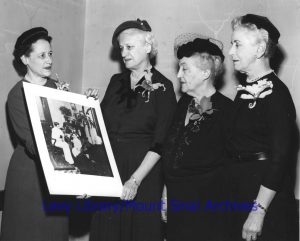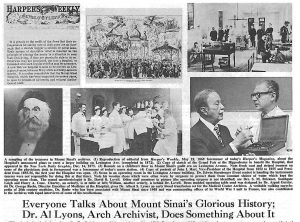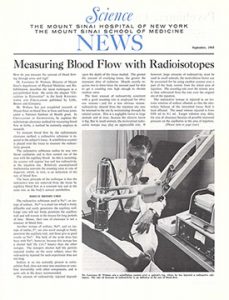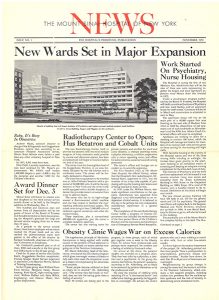Aug 27, 2020
This is a guest blog post by summer intern, Lily Stowe-Alekman. Lily is a junior at Smith College where she studies History, Archives, and the Study of Women and Gender.
Even before given access to traditional pathways of change, women at The Mount Sinai Hospital have worked to make change in the institution. From the opening of The Mount Sinai Hospital in 1855, the wives and daughters of the Board of Trustees worked to provide services in order to provide comfort to patients and to address their social and emotional well-being. By 1917, the first year that women were allowed on the Board, the role of women, and their expectations of that role, had substantially changed. The growing power of women was expressed by the creation of their own organization to exert influence over the life of the Hospital, the Social Service Auxiliary. And according to Helen Rehr, DSW, the second Edith J. Baerwald Professor of Community Medicine (Social Work), they were a force to be reckoned with.1 When prompted in an interview about the Auxiliary, “…they weren’t social butterflies having their tea. That’s not an image you would draw,” Rehr responded “Not these women, never. In the 28 years that I’ve known them I don’t recall having tea with them. No, they were women who came with a commitment to the social organization.” Hortense Hirsch, who served on the Auxiliary Board and Board of Trustees as one of the first woman able to be a Trustee, is a powerful example of the trailblazing women of the Auxiliary Board.

A portrait of Hortense Hirsch, circa 1960.
In 1923, Mrs. Hortense Hirsch (1887-1990) began her work with the Social Services Auxiliary (today’s Auxiliary Board), of which she would continue to be a member for sixty-five years, including a tenure as president from 1951-1956. From there, she was elected to the Board of Trustees in 1932, where she remained until becoming an honorary trustee in 1986. She sat on several committees of the Board, including as a member of the Committee on Building Maintenance and Equipment, Vice-Chairman of the Committee on Social Service, Chairman of the Committee on Convalescent Care, and as a member of the Committee on Ladies’ Auxiliary. Hirsch was president of the Neustadter Home for Convalescents beginning in 1937 when the Home affiliated with Mount Sinai, until she stepped down from the post in 1953.

A photograph of (from left to right) Helen Benjamin, member of the Women’s Auxiliary Board; Mrs. Edith Lehman, the first President of the Auxiliary Board from 1916-1917, Mrs. Ruth Cook, President from 1917-51; and Mrs. Hortense Hirsch, the presiding President of the Board at the fiftieth anniversary of the Auxiliary Board in 1956. Helen Benjamin holds a picture of the first social work volunteer from 1907.
Hortense Hirsch lived to be 103 years old, and by all accounts she remained steadfast in her dedication to social work and volunteerism for her whole life. After she graduated from Smith College in 1907 at the age of 19, she married Walter Hirsch and then moved to New York City in 1909. She began her work as a volunteer at Mount Sinai in 1917. The Federation of Jewish Philanthropies later referred to her as the “honorary ‘Dean of Social Work Volunteers.’” As a thoroughly involved volunteer and then Auxiliary Board member, Hirsch dedicated many hours to the hospital. Dr. Helen Rehr remarked in 1982, “The demands on her were great, but she always rose to it. There was no question on that score.”

Portrait of Hortense Hirsch, circa 1976.
Hortense Hirsch’s personality leaps off the pages of archival materials. When at Smith College, she maintained her own horse and buggy, which was against the rules, by paying a farmer for boarding, effectively evading the administration. In a New York Times article documenting her 100th birthday celebration, her daughter Carol Kridel told them, that while Hirsch was too ill to attend and she had to stay in bed, she was still “wearing a pink bedjacket and a pink bow in her silver hair.” The article also includes a story of Hirsch “[coming] to her 85th birthday and [tossing] her skirts high to show she approved of the latest rage—hotpants.”
Hortense Hirsch’s work on the Social Service and Women’s Auxiliary Board helped to transform the hospital. She worked tirelessly as a volunteer and board member. Hirsch’s work and legacy came from and continued those of the women who originally found pathways to affect changes at The Mount Sinai Hospital in the late 1800s. Hirsch served on the Board of Trustees, an opportunity that was not available to the women of previous generations. As Dr. Helen Rehr stated, “the Mrs. Hirsches are an outgrowth of that group of women who were the wives of the board of trustees” and ultimately transformed the hospital in the process.
Aug 21, 2020
This is a guest blog post by summer intern, Lily Stowe-Alekman. Lily is a junior at Smith College where she studies History, Archives, and the Study of Women and Gender.
As a summer intern with the Arthur H. Aufses, Jr., MD Archives, I have become acquainted with Mount Sinai’s history and the efforts that go into preserving its legacy. One of the projects I have worked on is cataloging The Mount Sinai Hospital News, an in-house tabloid-style newsletter for Mount Sinai employees. Colleen Stapleton, Patient Navigator for the Liver Education & Action Program at Mount Sinai, volunteered with the Archives this spring and digitized the newsletters from 1958-71. In my work cataloging, I read some really entertaining stories that offered a glimpse into the personal lives of people who worked in The Mount Sinai Hospital (later Medical Center), whether that be birth announcements of their children, quirky stories about the things employees did outside of the hospital, or articles about celebratory dinners and ceremonies. One can also not forget the hospital’s bowling team.
While cataloging in July, I came across a story that made me pause because it felt like a full circle moment. The October 1971 issue of The Mount Sinai Medical Center News featured an article called “Everyone Talks about Mount Sinai’s Glorious History; Dr. Al Lyons, Arch Archivist, Does Something About It.” This article has history of the Aufses Archives and is within the archive. While the Aufses Archives is a site of historical preservation, it has its own history as well.

Caption: The objects featured in the article header are still in the Arthur H. Aufses Jr. MD Archives today!
The creation of what is now the Arthur H. Aufses, Jr., MD Archives is due to the work and advocacy of Dr. Albert S. Lyons in the 1960s to 1980s. Over this time, Dr. Lyons advocated for the need of creating the archive and in 1986, secured its future with the hiring of a full-time archivist, Barbara Niss, who remains the Director today. Dr. Lyons (1912-2006) spent over sixty years of his life working at Mount Sinai. He began as a surgical resident at Mount Sinai Hospital in 1938. He went on to become the founder and Chief of the Intestinal Rehabilitation Clinic and worked to help support patient needs post-surgery. He was also a Clinical Professor of Surgery at the Mount Sinai School of Medicine. He wrote a well-known book, Medicine: An Illustrated History, a volume of over six hundred pages, charting medicine from the prehistoric era to the twentieth century.
Beyond his clinical work, Dr. Lyons was committed to Mount Sinai’s institutional history and to history of medicine in general. He taught the History of Medicine elective courses in the medical school. In the 1960s, he convinced the hospital board to collect the institutional history of the hospital. In 1966, he was made Hospital Archivist by Mr. Gustave L. Levy, the Chairman of the Board of Trustees. Dr. Lyons’ passion for preserving the history of The Mount Sinai Hospital overlapped with the discussions and planning of Mount Sinai School of Medicine, which welcomed its first students in the fall of 1968. In 1970, he was given the official title of Medical Center Archivist. Dr. Lyons also contributed a broad range of valuable materials to the Archives, including over eighty-five oral history interviews dating to 1965, a formative time for the field of oral history as well as for the Medical Center, as the School planned for and welcomed its first students.
In October of 1971, The Mount Sinai Medical Center News wrote about Dr. Lyons’ archival work. The article highlights the work and efforts of Dr. Lyons and serves as a call to action of sorts for the archive. Dr. Lyons is quoted in the first line as saying, “When in doubt, don’t throw it out.” He goes on to say that “too much of Mount Sinai’s past has already gone up in smoke,” due to people throwing out items without realizing their significance. He stresses as well that ordinary everyday materials are archival. He stresses that history is not necessarily in the distant past, that the events of the previous day are history. In this sense, Dr. Lyons de-mystifies the archives by showing that it should be in connection with the present moment and is not a disconnected abstract institution. The closing paragraph of the article instructs readers, “If you’ve uncovered some papers or objects you think may be worth saving, are planning some event to make current Medical History, etc. Drop Dr. Lyons a note.” In turn, “He and the Future will thank you!”
SOURCES
Arthur H. Aufses, Jr. MD Archives and Records Management. “Lyons, Albert S., MD, Papers, 1932-2000.” Collection Guides. https://icahn.mssm.edu/about/ait/archives/collection/albert-lyons.
Aufses, Arthur H., Jr., and Barbara Niss. This House of Noble Deeds: The Mount Sinai Hospital, 1852-2002, New York University Press, 2002. ProQuest Ebook Central, xi.
“Everyone Talks About Mount Sinai’s Glorious History; Dr. Al Lyons, Arch Archivist, Does Something About It.” Mount Sinai Medical Center News. October 1971. 5, 10.
Jun 11, 2020
This is a continuation of a guest blog post by Colleen Stapleton. Colleen is a Patient Navigator with the Liver Education and Action Program (LEAP) at Mount Sinai, where she works to improve linkage to care for patients living with Hepatitis C. You can read the original post here.
Scanning
My first day scanning, the team and I addressed the technology involved in making our Mount Sinai News collection available online. I learned about the scanning specifications to best archive our newsletters digitally. These specifications included 300 dpi (dots per inch), “do not scale,” and others particular to our scanner.
I also learned how to navigate the interesting physical space of the IT office, where the scanner was placed in a small kitchenette. Since I was scanning during lunchtime, I saw a few lunches popped in and out of the microwave. I learned that I could go ahead and put the precious paper newsletters on a non-descript plastic yellow barrel drum object, but under no circumstances should papers be placed on the potentially wet nearby water cooler!
Starting with November of 1958, I began electronically piecing together our carefully preserved collection of Mount Sinai Hospital history.
Folding Paper
Gently unfolding each 60-odd year old newsprint was both a physical challenge and delight. I soon fell into the rhythm of scanning the first page, then the second, then switching to scanning the inserted third and fourth pages. Since the newsletters are not stapled, in total I would carefully reverse the seams of two folded pages, then finish up with the back section of the first folded page.
After a few sessions, I noticed that the newsletters were getting considerably longer – some included 12 pages! This 12-page spread would include a total of three seams, and so unfolding and folding would come to resemble the act of taking apart and putting back together a precious Russian doll.
Troubleshooting
My first day at the scanner I became aware that any file containing more than five pages could not be sent via email to our Archives team account. I made the decision at this time to scan four pages at a time, sending the files to the Archives account in pieces. I soon saw the stacks of newsletters flowing from the “un-scanned” to the “scanned” pile.
After each session I would return to my desk and make sure every issue was represented and the scan quality was good. The various parts of each issue were then virtually ‘stitched’ together. Though some months came and went without Mount Sinai Hospital News editions, each newsletter is marked chronologically with issue numbers.

The first Science News insert of the new Mount Sinai School of Medicine
One of my favorite developments in my scanning came with the advent of the Mount Sinai School of Medicine Science News, an insert that was developed as the medical school was founded and produced more and more significant scientific discoveries. There was also the Mount Sinai Medical Center News title change in November-December 1969 to correspond with the newly built school of medicine. The history of Mount Sinai was expanding before my eyes and I had to ensure my metadata reflected these changes!
Moving Forward with Metadata
After scanning part I of the MSH News archive, the team met with the Aufses Archives’ Digital Archivist to clarify our strategy moving forward. We confirmed our goal of making the Adobe PDFs of the News pages available online, creating a digital index of all MSH News electronic files, as well as providing readers with a search function powered by Optical Character Recognition (OCR) to more easily search the newsletter files.
We identified questions to the tune of “How should we put the PDF files online?” and “how can we most easily create an index to the publication?” We ultimately decided to OCR the PDF documents with Adobe and then dump the words into a database program used by the Aufses Archives called DBTextworks. We started with a few pilot issue files and we identified any necessary metadata fields for our project.
So began an exciting new phase: cleaning and inputting metadata. Unfortunately, this was interrupted by the COVID-19 pandemic and the need to stay home, and we have not been able to continue the scanning. However, the work continues with the efforts of a fantastic new summer intern working remotely — soon all of the scanned issues will be described and searchable.
Stay tuned for more blog installments exploring this digitization project along with coverage of the many unique historical Sinai snapshots found in the MSH News!
May 12, 2020
This year the world marks the 200th anniversary of the birth of Florence Nightingale (1820-1910.) Her name is known around the world and nurses everywhere enjoy the fruits of her labors today. She lived a long time ago in a very different world, but she enunciated the basic philosophy of modern nursing, and introduced statistics into the study of disease.
The Aufses Archives has copies of two of Miss Nightingale’s books: Notes on Nursing and Notes on Hospitals. The Mount Sinai Hospital School of Nursing, which existed from 1881-1971, had a small collection of Nightingale letters that they had gathered over the years. Some of these were given to the Columbia University School of Nursing in 1953, as shown in the image below.

From the Aufses Archives

Hospitals, schools of nursing, archives, and history of medicine collections will be marking the 200th anniversary of Florence Nightingale this year with celebrations, blog posts, exhibits and lectures. Here are links to just a few of those celebrations going on this year:
Nightingale: Lady and Legend at the National Library of Medicine: https://circulatingnow.nlm.nih.gov/2020/05/12/nightingale-lady-and-legend/ This includes this note on sources: The National Library of Medicine’s holdings of Nightingale materials are (unsurprisingly) extensive, with over seventy printed titles and editions. In addition, the Library holds a group of Nightingale letters written between 1845 and 1878, all of which may be read as part of the Florence Nightingale Digitization Project, and a copy of an oral history interview conducted by M. Adelaide Nutting (herself a giant in the history of nursing) in 1890. A transcript is available at http://oculus.nlm.nih.gov/2935116r.
A blog post on the University of Maryland, Baltimore School of Nursing ties to Nightingale: https://www2.hshsl.umaryland.edu/hslupdates/?p=4177
A blog post at the UCLA Library about the Elmer Belt FN Collection and other Nightingaleiana we have and use: https://www.library.ucla.edu/blog/special/2020/05/11/happy-birthday-florence-nightingale
Finally, there is a special exhibit at the Florence Nightingale Museum in London called Nightingale in 200 Objects, People & Places https://www.florence-nightingale.co.uk/200objects/ Sadly, the Museum is closed due to the pandemic and is struggling financially. As they note:
Nursing, washing your hands and evidence based-healthcare, pioneered by Florence Nightingale, have become more important than ever before and we’re calling upon our friends and supporters to help us preserve her story and legacy.
Apr 10, 2020
This is a guest blog post by Colleen Stapleton. Colleen is a Patient Navigator with the Liver Education and Action Program (LEAP) at Mount Sinai, where she works to improve linkage to care for patients living with Hepatitis C. Colleen is an advocate for innovative health literacy strategies and a volunteer with the the Arthur H. Aufses, Jr., MD Archives at the Icahn School of Medicine at Mount Sinai, where she hopes to complete a history project mapping women’s contributions to the hospital.
Inspiration
Every Tuesday and Thursday before the global shutdown due to SARS-CoV-2, I left my office on the Upper East Side of Manhattan and walked a few blocks down to the Icahn School of Medicine at Mount Sinai, the Annenberg Building on 5th Ave. The building, part of Mount Sinai Health System’s main hospital complex, is a labyrinth of offices and meeting spaces. On the 10th floor, next to IT offices and tucked behind the Otolaryngology suite, is the office of the Arthur H. Aufses, Jr., MD Archives.
I started volunteering with the archives as a way to keep in touch with my personal interests while working as a patient navigator on a public health project in the Mount Sinai Hospital Liver department. My interest in medical devices, most notably the Dalkon Shield IUD tragedy, had introduced me to historian Susan Perry’s fantastic project that took shape in her 1985 book Nightmare.
Perry’s work inspired me to scheme: how could I sharpen my historical eye? How could I hone my training in visual history and explore my personal investment in the stories of women in medicine? What I found in my project scanning and cataloguing Mount Sinai Health System newsletters, however, was much more upbeat than the project that had originally inspired me.
When I reached out to Mount Sinai’s archive I was generously invited to join a team dedicated to preserving the accomplishments of Mount Sinai providers, scientists, and workers. My lunch-hour task would be to make the Archives’ collection of newsletters more accessible to our archivists, and if possible the Archives’ online readership.
Collection

The first issue of The Mount Sinai Hospital News, which ran from 1958-1982
The Aufses Archives has many collections of newsletters. I am starting with the “Mount Sinai Hospital News.” The series consists of several large folders containing two sets of the title. The first newsletter set, set “one”, is known as the “preservation set.” As such, it isn’t handled frequently and contains the best copies. Set “two” contains the copies of the newsletter that are meant to be handled. This handling may occur when inquiries come in from several sources, including relatives of nursing school alumnae, providers previously employed by the hospital or medical school, and hospital or school departments sourcing historical projects, among others. Both sets are stored among the other contents preserved by the Archives.
The archives are not a museum, and so they contain mostly paper-based items and files pertaining to the history of the hospital and medical school. In addition to the collection of newsletters, the Archives includes photographs, meeting minutes, office files, and miscellanea. The collection does house selected objects, including some medical devices, dolls, and even a moulage kit from the 1990s recently passed along to the Emergency Department for use in emergency drills. One of the oldest objects, a ledger indicating notes from one of the first Mount Sinai Beth Israel board meetings, is written by hand in Yiddish and dates back to the 1890s.
The Plan
At the start of the project, the team discussed plans for indexing a collection of newsletters. Would we keep an Excel file of key terms, titles, and dates? Could we also digitize the newsletters? After thinking about the “what” that we would like to make available, we discussed the “how” and “why” of the project. How would the Archives’ online readership access tools to search the newsletter collection? Would we be able to leverage resources to make every issue available online? What were the costs and benefits of spending time uploading each issue digitally?
I was happy to volunteer my help with scanning the newsletters, due in part to my history with an old archive project at the Everson Museum of Art in Syracuse, NY. As a curatorial intern I had been dying to scan the museum’s collection of newspaper clippings highlighting exhibitions and visits by Yoko Ono and John Lennon among other fascinating historical happenings! As it happened, our crew in Syracuse was limited by resource shortages, and scanning would have to be pushed to the next summer.
After some thought and research into searchable PDF text formats, my inclination to scan and upload every issue into our database (then online) was accepted! I was carefully handed a small pile of newsletters, then headed into our neighboring IT office to commandeer the scanner for an hour. The process of scanning had begun!
Watch for Part II, coming soon.








